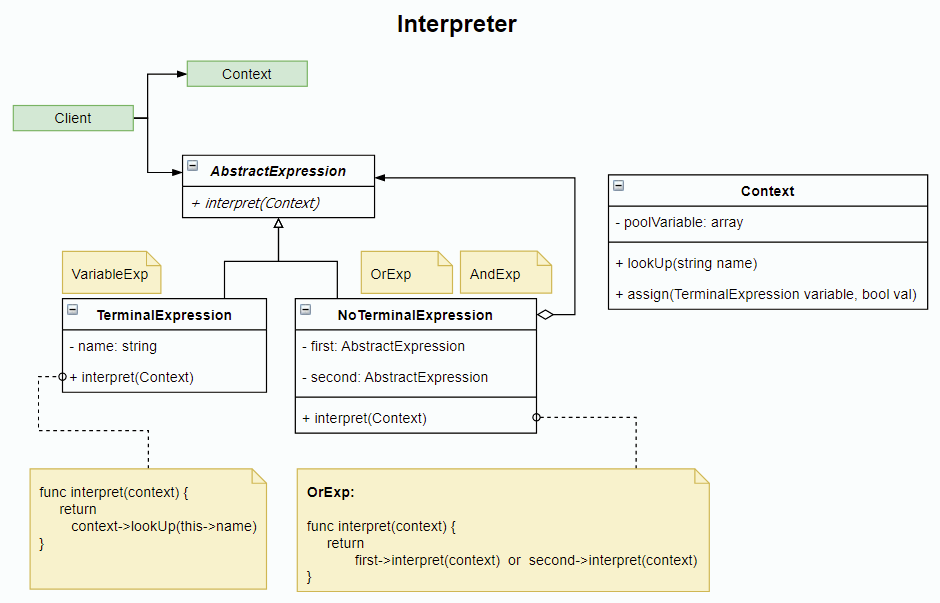Development Blog
Collection of development articles I've put together...
Interpreter Pattern
For a given language, it defines the representation of its grammar as "No Terminal Expression" and "Terminal Expression", as well as an interpreter for the sentences of that language.
0
Likes
Stuart Todd
•
2 years ago
•
Design Patterns: Behavioural
Purpose
The purpose of the design pattern
For a given language, it defines the representation of its grammar as "No Terminal Expression" and "Terminal Expression", as well as an interpreter for the sentences of that language.
Examples
Examples of how the design pattern can be used
An example of a binary logic interpreter, each definition is defined by its own class
UML
UML design pattern diagram

Code
Code snippets
AbstractExp
AbstractExp defines the interpret method signature. Any class extending AbstractExp must provide a method body for interpret.
namespace DesignPatterns\Behavioral\Interpreter;
abstract class AbstractExp
{
abstract public function interpret(Context $context): bool;
}
AndExp
AndExp extends AbstractExp and accepts two instances of AbstractExp via the construct. The interpret method is made concrete and accepts a Context class as a method parameter.
namespace DesignPatterns\Behavioral\Interpreter;
/**
* This NoTerminalExpression
*/
class AndExp extends AbstractExp
{
public function __construct(private AbstractExp $first, private AbstractExp $second)
{
}
public function interpret(Context $context): bool
{
return $this->first->interpret($context) && $this->second->interpret($context);
}
}
OrExp
OrExp extends AbstractExp and accepts two instances of AbstractExp via the construct. The interpret method is made concrete and accepts a Context class as a method parameter.
namespace DesignPatterns\Behavioral\Interpreter;
/**
* This NoTerminalExpression
*/
class OrExp extends AbstractExp
{
public function __construct(private AbstractExp $first, private AbstractExp $second)
{
}
public function interpret(Context $context): bool
{
return $this->first->interpret($context) || $this->second->interpret($context);
}
}
VariableExp
VariableExp extends AbstractExp and accepts a string via the construct. The interpret method is made concrete and accepts a Context class as a method parameter.
namespace DesignPatterns\Behavioral\Interpreter;
/**
* This TerminalExpression
*/
class VariableExp extends AbstractExp
{
public function __construct(private string $name)
{
}
public function interpret(Context $context): bool
{
return $context->lookUp($this->name);
}
public function getName(): string
{
return $this->name;
}
}
Context
The Context class has two methods; lookUp and assign that all concrete ‘exp’ classes have access to.
namespace DesignPatterns\Behavioral\Interpreter;
use Exception;
class Context
{
private array $poolVariable;
public function lookUp(string $name): bool
{
if (!key_exists($name, $this->poolVariable)) {
throw new Exception("no exist variable: $name");
}
return $this->poolVariable[$name];
}
public function assign(VariableExp $variable, bool $val)
{
$this->poolVariable[$variable->getName()] = $val;
}
}
IntepreterTest
Unit test showing an example of the Interpreter pattern.
namespace DesignPatterns\Behavioral\Interpreter\Tests;
use DesignPatterns\Behavioral\Interpreter\AndExp;
use DesignPatterns\Behavioral\Interpreter\Context;
use DesignPatterns\Behavioral\Interpreter\OrExp;
use DesignPatterns\Behavioral\Interpreter\VariableExp;
use PHPUnit\Framework\TestCase;
class InterpreterTest extends TestCase
{
private Context $context;
private VariableExp $a;
private VariableExp $b;
private VariableExp $c;
public function setUp(): void
{
$this->context = new Context();
$this->a = new VariableExp('A');
$this->b = new VariableExp('B');
$this->c = new VariableExp('C');
}
public function testOr()
{
$this->context->assign($this->a, false);
$this->context->assign($this->b, false);
$this->context->assign($this->c, true);
// A ∨ B
$exp1 = new OrExp($this->a, $this->b);
$result1 = $exp1->interpret($this->context);
$this->assertFalse($result1, 'A ∨ B must false');
// $exp1 ∨ C
$exp2 = new OrExp($exp1, $this->c);
$result2 = $exp2->interpret($this->context);
$this->assertTrue($result2, '(A ∨ B) ∨ C must true');
}
public function testAnd()
{
$this->context->assign($this->a, true);
$this->context->assign($this->b, true);
$this->context->assign($this->c, false);
// A ∧ B
$exp1 = new AndExp($this->a, $this->b);
$result1 = $exp1->interpret($this->context);
$this->assertTrue($result1, 'A ∧ B must true');
// $exp1 ∧ C
$exp2 = new AndExp($exp1, $this->c);
$result2 = $exp2->interpret($this->context);
$this->assertFalse($result2, '(A ∧ B) ∧ C must false');
}
}